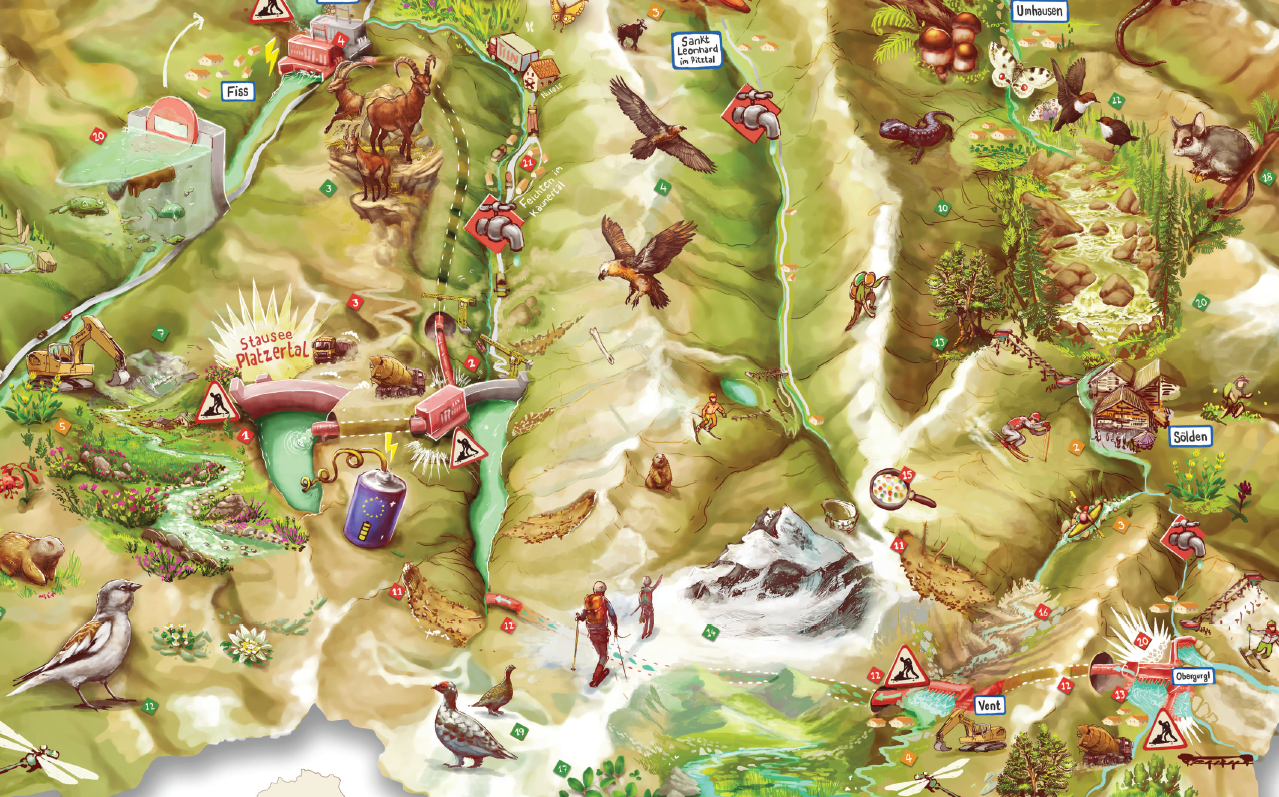The Kaunertal Extension Project
Kicking off this series of blog posts, we’ll take a closer look at what TIWAG (Tiroler Wasserkraft AG) actually plans to build. What would be constructed, how would it affect the environment, and what would it mean for the people living around the project area?
A “simple extension”? Hardly.
Fourteen years ago, TIWAG first presented plans to increase the energy output of the existing Kaunertal Hydropower Plant. The name — Kaunertal Extension Project — sounds harmless, suggesting a minor upgrade or efficiency boost.
But look closer, and you find a mega-project. It includes three new dams, over 30 km of new tunnels, the flooding of an untouched alpine wetland, and the diversion of up to 80% of the Ötztal’s headwaters — the Venter and Gurgler Ache — away from their natural valley.
All this water would be rerouted through the Kaunertal valley into the existing Gepatsch Reservoir, then released downstream into the Inn River for just a short stretch before being captured and piped again into yet another power plant.
Explore this map to get to know the project and read on for a breakdown.
1. Water diversion from the Ötztal
The Ötztaler Ache River — famous among kayakers, farmers, and tourists alike — is formed by the Venter and Gurgler Ache near Sölden. Its flow is fed by glaciers high in the Ötztal Alps, meaning water is abundant in summer and scarce in winter — exactly opposite to the demand for electricity.
Still, TIWAG sees this as unused potential. Their plan is to build two dams high up in the Ötztal to divert water through a 25 km tunnel system into the Kaunertal, before it ever reaches the Ötztaler Ache.
The consequences would be devastating:
- Up to 80% of the river’s flow would be lost from the valley.
- Local farmers and tourism businesses would face water shortages in an already dry region, while TIWAG would gain the water rights for the next 90 years.
- The natural, glacier-fed flow that sustains rare aquatic life and dynamic habitats would collapse.
This part of the project — the Ötztal transfer — is currently being pushed separately from the rest, a strategic move by TIWAG to reduce public opposition, and is therefore not yet part of the Environmental Impact Assessment that started in July 2025.
2. Pumped-storage system in the Platzertal
In the Kaunertal lies the existing Gepatsch reservoir, which was built between 1961 and 1964. Parallel to the Kaunertal Valley lies the little-known Platzertal — a high, secluded valley home to a mosaic of alpine wetlands, peatlands, and meadows. Because it is difficult to reach, this valley has remained one of the last near-pristine ecosystems in Tyrol — and a vital carbon sink.
TIWAG’s plan? To flood it.
A 120-metre-high dam would create a 44 million m³ reservoir, submerging about 90 hectares of wetland.1 Water would be pumped up from the existing Gepatsch Reservoir during times of low electricity demand and released again when demand is high — turning the valley into a massive “battery”. Note that this system doesn’t generate renewable energy; it merely stores it.
Meanwhile, construction would mean:
- Huge excavation sites and blasting zones.
- Over 6 km of access tunnels, a 4 km service road, and spoil dumps covering 13 hectares.
- Decades of noise, dust, and truck traffic through the Kaunertal valley.
Even more worrying is the instability of the mountainside above the existing Gepatsch Reservoir. A major landslide here could trigger a disaster similar to the 1963 Vajont catastrophe in Italy, as researchers have found that nearly 300 million cubic meters of rock are unstable. The reason? The constant change in water level in the reservoir due to the operation of the dam. Adding a pump-storage system will only increase the risk.2
3. Hydropower generation on the Inn
The diverted and stored water would eventually reach the Prutz Power Plant, expanded to handle peak-energy generation. When released in bursts, it would cause hydropeaking — sudden, extreme fluctuations in river level that are catastrophic for fish, invertebrates, and riverbanks.
After just a few kilometres in the Inn, the water would be captured again and sent through another power station before continuing downstream.
4. Why this project is out of time
The Kaunertal Extension would destroy entire valleys, wetlands, and rivers — all in the name of a “green” energy transition. It’s a project from another era, when hydropower was seen as limitless and harmless.
But today, we know better.
We are living through both a climate and biodiversity crisis. Flooding alpine wetlands and diverting glacier rivers for marginal energy gains cannot be the way forward. By the time construction would finish — at least ten years from now — more efficient and less destructive energy solutions will already have taken centre stage.
In the next blog posts, we’ll explore why this project directly violates EU laws — including the Water Framework Directive — and what can still be done to stop it.
Thank you for reading, sharing, and standing with us to protect the rivers of Tyrol.


